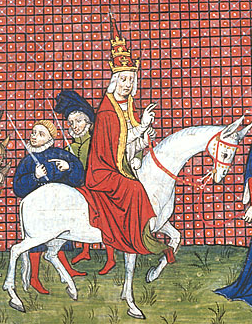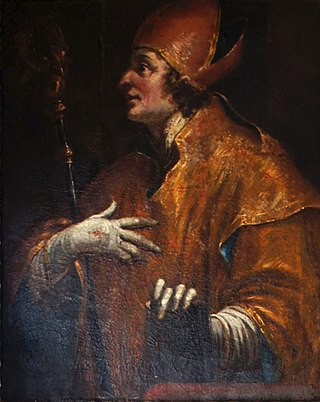Related Research Articles

Baldassarre Cossa was Pisan antipope John XXIII (1410–1415) during the Western Schism. The Catholic Church regards him as an antipope, as he opposed Pope Gregory XII whom the Catholic Church recognizes as the rightful successor of Saint Peter. He was also an opponent of Antipope Benedict XIII, who was recognized by the French clergy and monarchy as the legitimate Pontiff.

The Council of Constance was an ecumenical council of the Catholic Church that was held from 1414 to 1418 in the Bishopric of Constance (Konstanz) in present-day Germany. The council ended the Western Schism by deposing or accepting the resignation of the remaining papal claimants and by electing Pope Martin V. It was the last papal election to take place outside of Italy.

Pope Martin V, born OttoColonna, was the head of the Catholic Church and ruler of the Papal States from 11 November 1417 to his death in February 1431. His election effectively ended the Western Schism of 1378–1417. He is the last pope to date to take on the pontifical name "Martin".

Pope Boniface IX was head of the Catholic Church from 2 November 1389 to his death, in October 1404. He was the second Roman pope of the Western Schism. During this time the Avignon claimants, Clement VII and Benedict XIII, maintained the Roman Curia in Avignon, under the protection of the French monarchy. He is the last pope to date to take on the pontifical name "Boniface".

Pope Gregory XI was head of the Catholic Church from 30 December 1370 to his death, in March 1378. He was the seventh and last Avignon pope and the most recent French pope recognized by the modern Catholic Church. In 1377, Gregory XI returned the Papal court to Rome, ending nearly 70 years of papal residency in Avignon, France. His death was swiftly followed by the Western Schism involving two Avignon-based antipopes.

The Avignon Papacy was the period from 1309 to 1376 during which seven successive popes resided in Avignon rather than in Rome. The situation arose from the conflict between the papacy and the French crown, culminating in the death of Pope Boniface VIII after his arrest and maltreatment by Philip IV of France. Following the subsequent death of Pope Benedict XI, Philip forced a deadlocked conclave to elect the French Clement V as pope in 1305. Clement refused to move to Rome, and in 1309 he moved his court to the papal enclave at Avignon, where it remained for the next 67 years. This absence from Rome is sometimes referred to as the "Babylonian captivity of the Papacy".

The Council of Florence is the seventeenth ecumenical council recognized by the Catholic Church, held between 1431 and 1449. It was convoked as the Council of Basel by Pope Martin V shortly before his death in February 1431 and took place in the context of the Hussite Wars in Bohemia and the rise of the Ottoman Empire. At stake was the greater conflict between the conciliar movement and the principle of papal supremacy.

The Western Schism, also known as the Papal Schism, the Great Occidental Schism, or the Schism of 1378, was a split within the Catholic Church lasting from 1378 to 1417 in which bishops residing in Rome and Avignon both claimed to be the true pope, and were joined by a third line of Pisan claimants in 1409. The schism was driven by personalities and political allegiances, with the Avignon Papacy being closely associated with the French monarchy.

Pierre d'Ailly was a French theologian, astrologer and cardinal of the Roman Catholic Church.

Febronianism was a powerful movement within the Catholic Church in Germany, in the latter part of the 18th century, directed towards nationalising Catholicism, restricting the power of the papacy in favour of the episcopate, and reunion of dissident churches with the Catholic Church. Its thrust broadly corresponded to that of Gallicanism in France. Friedrich Lauchert describes Febronianism, in the Catholic Encyclopedia, as a politico-ecclesiastical system, ostensibly purposed to facilitate reconciliation of Protestant entities with the Catholic Church by curbing the Holy See's power.
The Fifth Council of the Lateran, held between 1512 and 1517, was the eighteenth ecumenical council of the Catholic Church and was the last council before the Protestant Reformation and the Council of Trent. It was convoked by Pope Julius II to restore peace between Catholic rulers and assert the authority of the Pope.
Annates were a payment from the recipient of an ecclesiastical benefice to the collating authorities. Eventually, they consisted of half or the whole of the first year's profits of a benefice; after the appropriation of the right of collation by the Roman see, they were paid to the papal treasury, ostensibly as a proffered contribution to the church. They were also known as the "first fruits", a religious offering which dates back to earlier Greek, Roman, and Hebrew religions.
The Declaration of the Clergy of France was a four-article document of the 1681 assembly of the French clergy. Promulgated in 1682, it codified the principles of Gallicanism into a system for the first time into an official and definitive formula.
The Concordat of Bologna (1516) was an agreement between King Francis I of France and Pope Leo X that Francis negotiated in the wake of his victory at Marignano in September 1515. The groundwork was laid in a series of personal meetings of king and pope in Bologna, 11–15 December 1515. The concordat was signed in Rome on 18 August 1516. It marked a stage in the evolution of the Gallican Church.

Konstanz Minster or Konstanz Cathedral is a historical building in Konstanz, southern Germany, the proto-cathedral of the former Roman Catholic diocese of Konstanz.

Rinaldo Brancaccio was an Italian cardinal from the 14th and 15th century, during the Western Schism. Other members of his family were also created cardinals: Landolfo Brancaccio (1294); Niccolò Brancaccio, pseudocardinal of Antipope Clement VII (1378); Ludovico Bonito (1408); Tommaso Brancaccio (1411); Francesco Maria Brancaccio (1633) and Stefano Brancaccio (1681). He was called the Cardinal Brancaccio.

According to the Catholic Church, a Church Council is ecumenical ("world-wide"), if it is "a solemn congregation of the Catholic bishops of the world at the invitation of the Pope to decide on matters of the Church with him". The wider term "ecumenical council" relates to Church councils recognised by both Eastern and Western Christianity.
BeatoEnrico Scarampi was an Italian churchman from the prominent Scarampi family of the area of Asti, active at the time of the Western Schism.

Hermann of Cilli, also known as Armand de Cilli, or Herniosus mit dem Bruche, was born in Cilli, the illegitimate son, although later legitimated, of Count Hermann II of Celje, of the family of the Counts of Cilli and Sanneck, whose family seat was in Celje Castle.
Antoine de Challant, was a Savoyard cleric who served as Chancellor of the Count of Savoy and was coopted into the papal curia by Pope Benedict XIII of the Avignon Obedience, who created him a cardinal and named him Archbishop of Moûtiers-Tarentaise. He served principally as a diplomat for the pope in negotiations directed toward the settling of the Great Western Schism, though his efforts had to be directed mostly to keeping Benedict from being repudiated by the French government. He himself finally abandoned Benedict and joined the cardinals who called for a general council of the Church. He participated in the Council of Pisa, and was one of the electors of Pope Alexander V. He also participated in the Council of Constance, and was one of the electors of Pope Martin V.
References
- ↑ "The Italian peninsula might have been made of many city states, papal states, and the Kingdom of Naples, and the Duchy of Milan, with no single over-arching government, but it was a nation in the sense that all its prelates were regarded in the eyes of the Church as being part of the Italian nation"
- ↑ Semeria, Giovanni B. (1843). "Secoli Cristiani della Liguria".
- ↑ All four surviving agreements are published in Giovanni Mercati, ed., Raccolta di concordati su materie ecclesiastiche tra la Santa Sede e le autorità civili, 1098–1914 (Vatican City, 1954), vol. I, pp. 144–68.
- 1 2 3 Mandell Creighton, A History of the Papcy during the Period of the Reformation, Vol. I: The Great Schism—The Council of Constance, 1378–1418 (Boston: Houghton, Mifflin & Co., 1882), pp. 406–07.
- ↑ Joseph M. McCarthy, "English Concordat of 1418", in Ronald H. Fritze and William B. Robison, edd., Historical Dictionary of Late Medieval England, 1272–1485 (Westport, CT: Greenwood Press, 2002), pp. 191–92.
- ↑ Phillip H. Stump, The Reforms of the Council of Constance (1414–1418) (Leiden: E. J. Brill, 1994), p. 47, note 64.